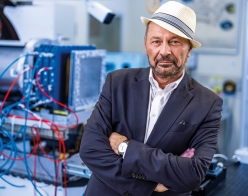
This year sees the 50th anniversary not only of the proposal of quarks, but also of what is arguably one of the most groundbreaking theoretical findings in physics: Bell’s theorem (Bell 1964).
To celebrate the theorem and the work of the Irish physicist John Stewart Bell, who was on leave from CERN when he wrote his seminal paper, the university of Vienna held the conference Quantum [Un] Speakables II on 19–22 June. Distinguished invited specialists in the question of non-locality brought up by Bell’s theorem discussed the impacts of the theorem and the future of scientific investigations, together with 400 participants.
John Clauser, who was the first to investigate Bell’s theorem experimentally, mentioned the difficulties he had in acquiring money for his experiments. The breakthrough did not come until the 1980s, when Alain Aspect measured a clear violation of Bell’s proposed inequalities. The philosophical debate between Niels Bohr and Albert Einstein on whether quantum mechanics is complete or not thus seemed also to be settled experimentally – in favour of Bohr. In his talk, Aspect stressed Bell’s ingenious idea to discover the practical implications of what had until then been merely a philosophical debate.
An important further development of Bell’s theorem was the Greenberger– Horne–Zeilinger experiment, in which the entanglement of three instead of only two particles was considered. Another important contribution was achieved with the Kochen–Specker Theorem – next to Bell’s theorem, this is the second important “no-go” theorem for hidden variables in quantum mechanics. In their talks, Daniel Greenberger, Michael Horne and Simon Kochen focused on current questions in their research. Anton Zeilinger, who was co-chair of the conference with Reinhold Bertlmann, stressed the huge impact of Bell’s theorem for technical applications: quantum computing, quantum teleportation and quantum cryptography, which are based on the concept of non-locality as outlined by Bell.
More personal remarks came from Bertlmann, who had worked with Bell as a postdoc at CERN and is the protagonist of his famous paper “Bertlmann’s socks and the nature of reality”, and from Bell’s widow Mary Bell, an accelerator physicist.
The conference title refers to a paper that Bell wrote in 1984, in which he identified what he called “unspeakables”. These are notions that he wanted to eliminate from the vocabulary of physics, because for him they did not qualify as well defined – among them measurement, apparatus and information. However, the title also allowed for another meaning. After 50 years, many important implications of Bell’s theorem have been found, but there is much that follows from the theorem that no one talks or even thinks about yet, and so is still to discover.








